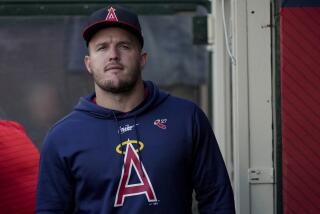Wide-Open Skies Lured Carlsbad Woman to Fame, Daring in ‘20s
- Share via
Custom dictates that 84-year-old women don’t charge around town in bright red Porsches.
But a sports car is actually in a slow league for Bobbi Trout, a world-famous 1920s aviator and friend of Amelia Earhart who today lives quietly, except for the modest revving of her car engine, in Carlsbad.
Trout always hated the notion of a life of dirty dishes and housework and instead chose emergency landings in fields, grueling endurance flights and the glory of an earlier time.
She was a pioneer of aviation’s Golden Age, and today, left with her memories, she’s videotaping interviews with other flight pioneers. But most of the women she knew and competed against are dead now, leaving her among the few who remember how it was.
“I was flying when it was wide open, you were as free as a bird,” said Trout, who knew of much of the Los Angeles area when it was a vast quilt of fields and farms, where people stopped what they were doing and waved when a plane gracefully interrupted the sky.
Of modern aviation, she said, “There are too many in it, you’re a number. We used to be a person. There are too many rules and regulations that take the joy out of it.”
For Trout, making her own rules and regulations has won her a place in history.
She held the women’s pilot endurance record of 12 hours, 11 minutes in 1929, promptly lost it, and won it back. She was awarded the coveted Aviation Gold Cross from the Federation Aeronautique Internationale, the world honorary flying organization that issued Trout a license signed by Orville Wright.
At the San Diego Aerospace Museum, Trout’s name is engraved in the Women’s Hall of Fame, alongside the names of “women widely known around the world,” said archivist Ray Wagner.
“She was an example of a spirit of adventure and courage some young women showed in advancing the popularity of aviation,” Wagner said.
When Dr. Peggy Baty, associate dean of academics at Embry-Riddle Aeronautical University campus in Prescott, Ariz., where Trout was recently honored, thinks about the most courageous early women fliers, she said: “In the ‘20s and ‘30s, I see four names: Amelia Earhart, Louise Thaden, Bobbi Trout and (Florence) Pancho Barnes.”
Earhart vanished into mysterious immortality in 1937, and Barnes and Thaden died in the 1970s.
Trout sits in her condominium amid flight memorabilia and summons to mind a snowy day in 1918 when she trudged home from school in Ontario, where she was then living with her family. A biplane droned overhead. “Oh my god, it thrilled me to death, I knew someday I’d learn to fly,” she said.
That year, she moved back to the Midwest, where she contracted influenza during a nationwide epidemic that killed thousands. After months of recuperating, her lungs remained scarred, and the Trouts boarded the train for the better climate of Southern California.
Ten years later, Trout finally paid $250 to learn to fly, which in retrospect seems rather expensive for a near-death experience. She and her instructor, Dale Page, were aloft in a two-seat, open-cockpit OX5 Jenny when he cut the throttle, failed to lower the nose and the plane spun 100 feet into a field.
Trout suffered a concussion and cuts, and her mother urged her to forsake airplanes. “Why?” Trout responded with typical aviator logic. “If I’d been killed, I wouldn’t have known about it.”
A year later, Trout was world-famous.
She zoomed up in the predawn darkness of Jan. 2, 1929, over Van Nuys Airport in a Golden Eagle monoplane, hoping to break the women’s pilot endurance record of eight hours. She circled endlessly around the airport for 12 hours and 11 minutes before making her first night landing and encountering a surprise.
“I didn’t expect to see photographers and a crowd around me. I just knew I was running out of gas and should set down,” Trout said.
Almost instantly, Trout became a worldwide sensation, although there are some less-enthusiastic recollections of her feat.
In his memoir of early American aviation, pioneer flier Waldo Dean Waterman writes that Trout’s marathon flight infuriated then-Maj. Carl Spaatz, who years later commanded the 8th Air Force in Britain and became the first Air Force chief of staff.
Spaatz was trying to establish an endurance test flight for aerial refueling and engine operation for the U.S. Army Air Service when his tri-motor craft approached the field where Trout was circling.
Waterman, who was at the field, noted that, when Spaatz “discovered there was another plane flying around in his air space, he really raised hell, sending me a message to ‘get that damn plane out of there right now!’ ”
“My reply was, ‘What do you want me to do, shoot her down?’ ” Waterman said.
When Trout recently learned about this footnote to flight history, she replied, “I received a nice little letter (of congratulations) from Spaatz.” Then she added with slight annoyance, “Evidently it didn’t bother him too much.”
However, Trout’s triumph was short-lived as another woman pilot, Elinor Smith, posted a 13-hour flight only a few days later. So, Trout attempted to break the record again, and, on Feb. 9, 1929, she soared above Mines Field in Inglewood in her 60-horsepower Golden Eagle and stayed up 17 hours and 20 minutes.
Bored amid the blackness of night and the monotonous engine drone, Trout said, “I went to sleep a few times, and when I went into a dive, the engine awakened me.” She rubbed her neck and sang to pass the hours.
When she landed, she had shattered records for endurance, mileage and takeoff weight. “That was the first time a woman had stayed up all night in the air,” she said.
The flight built her reputation as she grabbed new headlines, such as “Sky Girl Sets Mark,” an account in a Los Angeles newspaper that described the 22-year-old aviator as a “tomboy who took up flying to avoid dishwashing. . . .”
There was considerable truth in that characterization. Trout has always said that dolls, marriage and the traditional life of a woman of her era never interested her. “Mother wanted me to be a lady, and she didn’t get one, that’s all,” said Trout.
But mother, Lola Trout, touted her suddenly prominent daughter to newspaper reporters as a “wonderful baby.”
Although her actual first name is Evelyn, she was called Bobbi because she bobbed her hair in 1924. She preferred pants over dresses, used to shoot rattlesnakes in the backcountry and enjoyed helping run her family’s gas station in Los Angeles. She never married.
It seemed that almost everybody knew her from her photographs, in which she wore English riding boots, a leather flight jacket, cap and goggles. “I’d go down the street, and I’d hear people say, ‘There goes Bobbi Trout,’ ” she remembers.
She even consented to commercial endorsements for Nash cars and Richfield gasoline and motor oil.
Those were days of heroes, heroines and legends, and Trout met them all.
Remembering Charles Lindbergh, she said he “was rather quiet and distant. He had a weak handshake. That was one thing everybody talked about.”
She was a friend of Amelia Earhart, who became the most famous American aviator after she crossed the Atlantic alone. Despite the rivalries among women fliers, Trout said they were cordial and supportive of one another.
“She was a lovely girl, I liked Amelia very much,” Trout said. “She was always sweet and charming.”
In June, 1937, Earhart, 38, and her navigator, Fred Noonan, disappeared during an around-the-world flight as they headed toward a Pacific island. Some have speculated that she was on a pre-World War II military intelligence-gathering mission and was captured by the Japanese, but Trout called that “just ridiculous.”
Trout firmly believes Earhart, who “hated trailing antennae,” had the appendage removed from her craft. She was probably near the island but couldn’t find it or maintain radio communication. Trout thinks Earhart made a fatal mistake by not taking along a navigator who could also operate the radio. “She messed up when she didn’t take a radio operator with her.”
When Earhart was lost, “We were all just sick,” she said. After all these years, Trout’s voice still drops when she talks about it.
In the ‘30s, Trout went on to other famous exploits, including a 122-hour endurance flight with Edna May Cooper, and a fair share of emergency landings. She also tried to get hired as an airline pilot, but was spurned. They thought that, if a woman was flying the plane, “they wouldn’t get any passengers,” she said.
During World War II, Trout owned a small defense contracting company, quit flying in 1946 and spent the years until retirement in real estate and other ventures. She moved to Carlsbad 14 years ago and wrote a biography, “Just Plane Crazy.”
More to Read
Sign up for Essential California
The most important California stories and recommendations in your inbox every morning.
You may occasionally receive promotional content from the Los Angeles Times.













